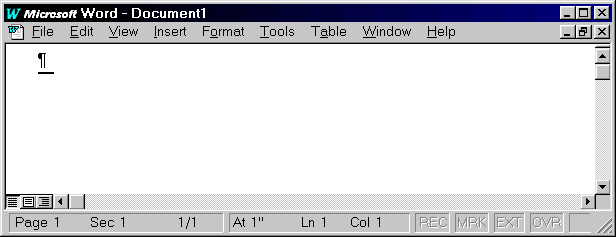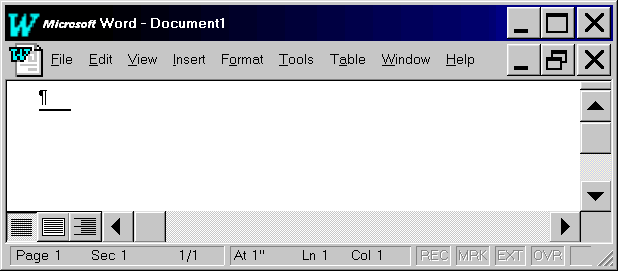
Using the simple properties in the NonClientMetrics class is just like using properties in any other class. First, you create a new instance of the object, and then you set and retrieve its properties. For example, to add five pixels to the width of the scrollbars, you could use code like this:
Dim ncm As New NonClientMetrics
ncm.ScrollWidth = ncm.ScrollWidth + 5To test out most of the simple properties, the code in Listing 9.10 exercises most of the simple NonClientMetrics properties. Figure 9.14 shows a simple window before the code is called, and Figure 9.15 shows the same window after the code has done its work. As you can see, the NonClientMetrics class provides properties to control most of the visual aspects of the window border.

Figure 9.14: A simple window before FixNCM is called

Figure 9.15: The same window after FixNCM is called
Listing 9.10: Modify Most of the Simple NonClientMetrics Properties
Sub FixNCM()
Dim ncm As New NonClientMetrics
ncm.BorderWidth = ncm.BorderWidth * 2
ncm.CaptionHeight = ncm.CaptionHeight * 2
ncm.CaptionWidth = ncm.CaptionWidth * 2
ncm.MenuHeight = ncm.MenuHeight * 2
ncm.MenuWidth = ncm.MenuWidth * 2
ncm.ScrollHeight = ncm.ScrollHeight * 2
ncm.ScrollWidth = ncm.ScrollWidth * 2
End SubSetting all these properties is a slow process. If you intend to change multiple NonClientMetrics properties often, consider removing the calls to SaveSettings in each property’s code and explicitly calling the SaveSettings method yourself once you’ve made all the changes. That way, Windows won’t attempt to change all the settings individually, and your code will run faster. To make these properties work like all simple properties, we wrote the code so that each Property Let procedure saves its changes. You’re welcome to change this behavior if you like.
In addition to its simple properties, the NonClientMetrics class provides five font properties. Each of these properties is a reference to a separate object, a Font object (FONT.CLS). Each Font object provides a set of properties describing a font used by a NonClientMetrics object, such as the font of the caption bar or the font used by the menus. In addition, the NonClientMetrics object maintains the font used by the form popped up by the MsgBox function. That’s right: from your own applications, you can control the font used by the standard MsgBox function.
To use the font properties, treat them as objects contained within the NonClientMetrics object. For example, to retrieve the name of the font used by the MsgBox form, you could write code like this:
Dim ncm As New NonClientMetrics
Debug.Print ncm.MessageFont.FaceNameThe real difference between using the simple properties and using the Font object properties is that changes to the fonts aren’t saved until you explicitly call the SaveSettings method of the NonClientMetrics object. That is, once you’ve made all the font changes you need to make, you must use code like this:
Call ncm.SaveSettingsto cause the object to save all the new settings. You needn’t call this method at all if you’re only retrieving values or if you’re working only with the simple properties. If you want to modify font values, however, your changes won’t take effect until you call this method.
If you want to work extensively with the Font object, you could use the With statement, treating it like the real object it is. For example, the code in Listing 9.11 retrieves the current MsgBox font settings, modifies them, pops up a test message box, and then resets the values.
Listing 9.11: Sample Procedure That Modifies the MessageFont Object
Sub FixMsgBox()
Dim ncm As New NonClientMetrics
Dim strOldFont As String
Dim intOldSize As Integer
With ncm
With .MessageFont
strOldFont = .FaceName
intOldSize = .Size
.FaceName = "Tahoma"
.Size = 12
End With
Call .SaveSettings
MsgBox "This is a test"
With .MessageFont
.FaceName = strOldFont
.Size = intOldSize
End With
Call .SaveSettings
MsgBox "This is a test"
End With
End SubAs another example, the code in the following fragment sets the standard menu font to be two point sizes larger than it was originally and causes the font to be italic:
Dim ncm As New NonClientMetrics
With ncm.MenuFont
.Size = .Size + 2
.Italic = True
End With
Call ncm.SaveSettingsSome programs, including all of Microsoft’s Office 97 suite, eschew standard menus, using, instead, menus of their own creation. Changes you make to standard Windows menus will have no effect in these applications.